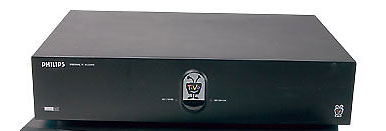
This is the TiVo HDR110. It’s so old it’s actually hard to find good online pictures of it If you were lucky enough in 1999, and you had a thousand bucks in your pocket, you could own this revolutionary DVR. It was a fairly large beast, but not a whole lot larger than a DIRECTV Genie DVR.
A thousand bucks?
Oh yeah, I did say $1,000. And I’m talking about over 20 years ago. Back then you could rent a decent apartment in most places for about $500 a month.
The specs for this DVR were formidable for the day, but a little laughable today. Its 13GB hard drive gave you the choice of roughly 6, 12, or 24 hours of recording, but all recordings were encoded on the fly and if you wanted the best quality you needed that 6-hour mode. Anything less gave your recordings a distinctly YouTube-like appearance. (Not that YouTube had been invented yet.) And keep in mind, this was standard-definition. This wasn’t anything like HD, that wouldn’t be on the horizon for half a decade.
That’s right, the first TiVo gave a a choice of SD quality or two levels worse than SD quality. But who cared? You could PAUSE LIVE TV for goodness sake! And let’s remind ourselves once again that this device, which cost 2 months’ rent, had about the same capacity as a video tape you could get for $4 at the local drug store.
Getting back to the specs
Back when such things were important, TiVos had a built-in RF modulator to work with any television, as well as a full complement of composite and S-Video ports.
The way TiVo’s worked in those days was a little confusing. If you had a cable or satellite box capable of serial control, then you hooked a cable to that tuner and TiVo could control it. Otherwise you had to rely on whatever internal timers were available on the cable or satellite box you had. Off-air recordings could be scheduled directly.
There was another little hitch. You see, the TiVo had one tuner. That meant one recording at a time. If the TiVo needed to control the cable box, it meant no watching one channel and recording another. If you wanted that capability, you needed to resort to multiple cable boxes and A/B switches, much as you would do with the VCRs of the day.
As a replacement for a VCR, TiVos back in 1999 were less than fantastic. For $1,000, you could get a very fancy VCR with multiple timers, editing capabilities and variable-speed fast forward/rewind. You also had infinite recording and storage capacity… just take one tape out and put another in. TiVo did a lot of the work for you and gave you a nice guide and list, but believe it or not, a $150 VCR of the day was a better choice.
The harbinger of things to come
That didn’t last long of course. TiVo and its competitors killed the VCR rather handily by mid-decade, and by 2009, the VCR with its analog-only recordings was pushed aside by digital television. By then, TiVos and other DVRs had features that folks in 1999 only dreamed of.
I’ll admit back then I didn’t think much of DVRs, and precisely for the reason I mentioned — they were a poor, overpriced replacement for a VCR (although YOU COULD PAUSE LIVE TV!!!!) and so I didn’t pick up one of those TiVos. Still, this device was the forerunner of a whole generation of DVRs that transformed the way we watched TV. Future home theater enthusiasts may see the DVR as nothing more than a gateway to the age of streaming TV, but whether or not that’s true they have to acknowledge the impact of this little TiVo. It should go down in history with the Motorola DynaTAC, the Betamax, the IBM PC, and the iPhone as important “firsts of their kind.”
The TiVo legacy
The DVR isn’t seen as the kind of cutting edge tech it once was. Why? Simply because most of us stream a lot now. It’s not necessary to store all your content locally. But it’s still a very decent part of most home theater systems. Not everything’s available online, especially local channels. And, it’s nice to have a playlist full of things you personally set up. Personally I find it more convenient than the “watchlist” functionality built into a lot of streaming apps.
TiVo, the company, was bought some years ago. They’re trying to compete in the streaming space now, in addition to making DVRs that few people buy. But at least they’re still out there.



